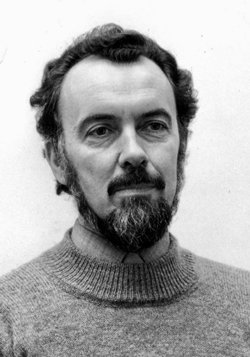Analytical explorer and investigator who furthered our understanding of different orogenic events.

Islands are not normally named after geologists; Geoff Tanner was an exception. Appointed to the British Antarctic Survey (BAS) for the 1975-76 season, Geoff explored a large field area in the South Georgia island arc and described how the arc had been disrupted from south America and Antarctica. Impressed by Geoff’s work, BAS and the UK Antarctic Place-Names Committee named the largest of the Pickersgill Islands, west of South Georgia, after him.
Peter William Geoffrey Tanner’s professional life was committed to clarifying how geologically complex segments of many ancient mountain belts had developed. Geoff achieved successful results through his own mapping and petrographic studies and by engaging with specialists on isotopic age-dating, geochemistry, and palaeontology.
Left: Geoff Tanner. Photo courtesy of Felix Tanner.
Orogenies and ore bodies
In the early 1960s, Geoff, a graduate of the University of Sheffield, roamed Kinloch Hourn, northwest Highlands of Scotland, for his doctorate at Imperial College London. He described the disruptive effects of the Sgurr Beag slide, a thrust that was active during deformation and metamorphism of the Moine schists. As it moved, the slide had scooped slivers of underlying Lewisian gneiss basement up into the Moine. My colleagues in the (then) Institute of Geological Sciences had great respect for Geoff’s work and for his zest for remote terrains. Many years later, one of them recounted how Geoff had taught him to guddle for trout in Highland burns.
At the University of Leeds, in the late 1960s, Geoff began researching the Irish Connemara Dalradian rocks with Professor Bernard Leake. They subsequently described how this complex area could be a detached terrane thrust out from the ancient continent of Laurentia.
In the early 1970s, Geoff investigated the structural setting of ore bodies in the huge Rwenzori Mountains, Uganda. This was a prelude to Geoff’s more recent research (early 2010s) on understanding where Scottish gold might occur near Tyndrum, Perthshire.
From 1975, with the University of Glasgow, Geoff went on to study the Dalradian of the Grampian Highlands, Scotland, addressing the age of deformation and metamorphism. Collaborating with Dr Peter Thomas, Geoff described major recumbent structures.
The 1990s saw Geoff, as an Honorary Research Fellow, investigating the entire extent of the Highland Border Complex of Scotland. Whereas prevailing opinion was that the Complex had been emplaced after the Grampian Orogeny, Geoff, collaborating with other specialists, analysed and re-examined outcrops and samples in earlier collections. This work showed that the Complex could have formed before the Orogeny, with some sections being in sequence with the Dalradian and others emplaced as remnants of ocean crust from the south.
Sense of humour
Geoff’s analytical and professional approach was leavened by a cheeky-looking grin, refreshing openness, and laconic sense of humour. One example was, when starting his 2008 Clough Medal lecture (awarded by Edinburgh Geological Society), Geoff openly acknowledged the shakiness of his hands due to Parkinson’s and announced that he had given the slide controller to a colleague “…otherwise this talk will be over in about 20 seconds”.
Geoff leaves daughter Oona, a G.P., son Felix, a classical musician, and wife, Judith, the mainstay of supporting his fieldwork by transcribing his words and editing his many papers in later years.
By Bill Henderson